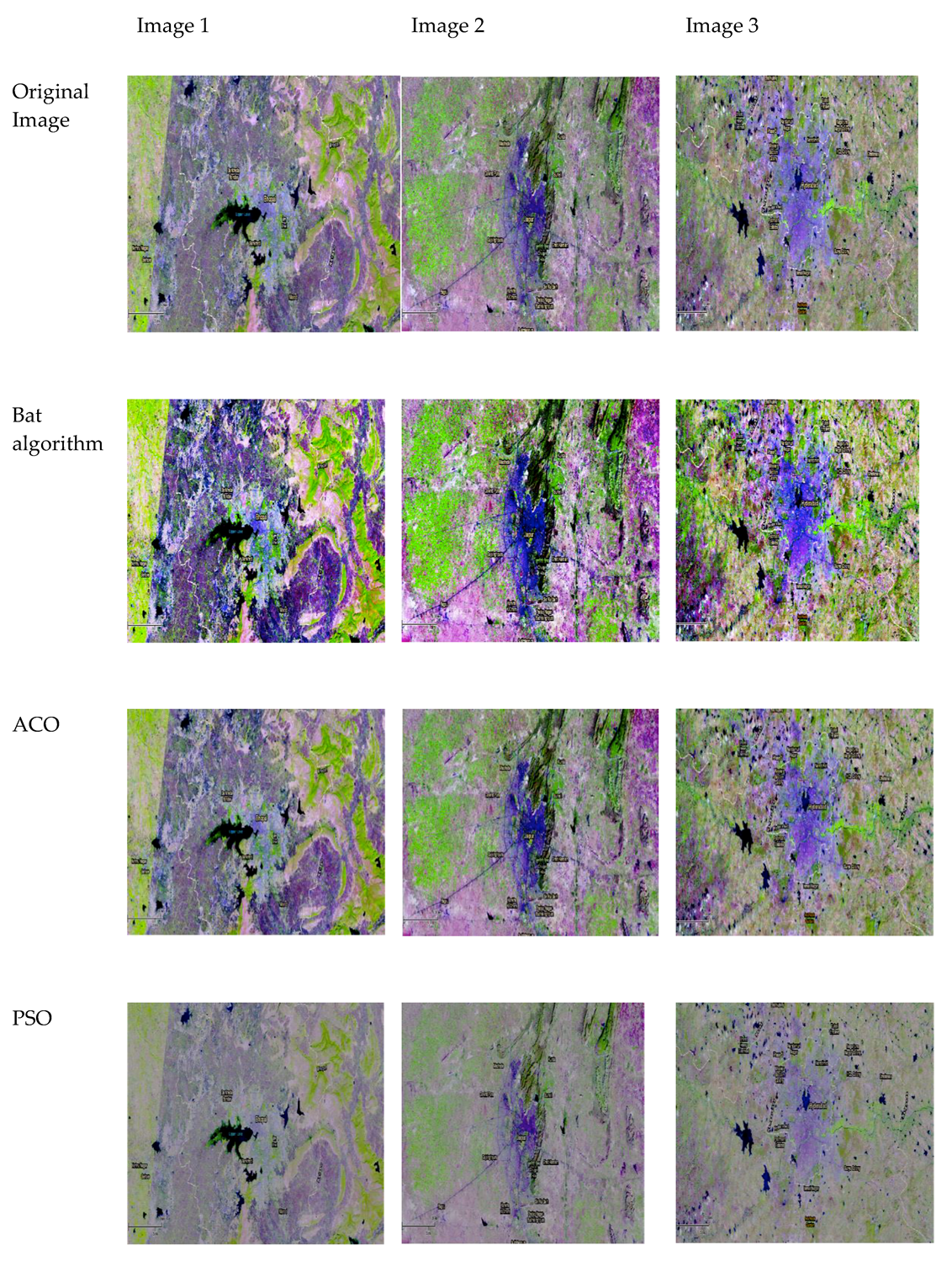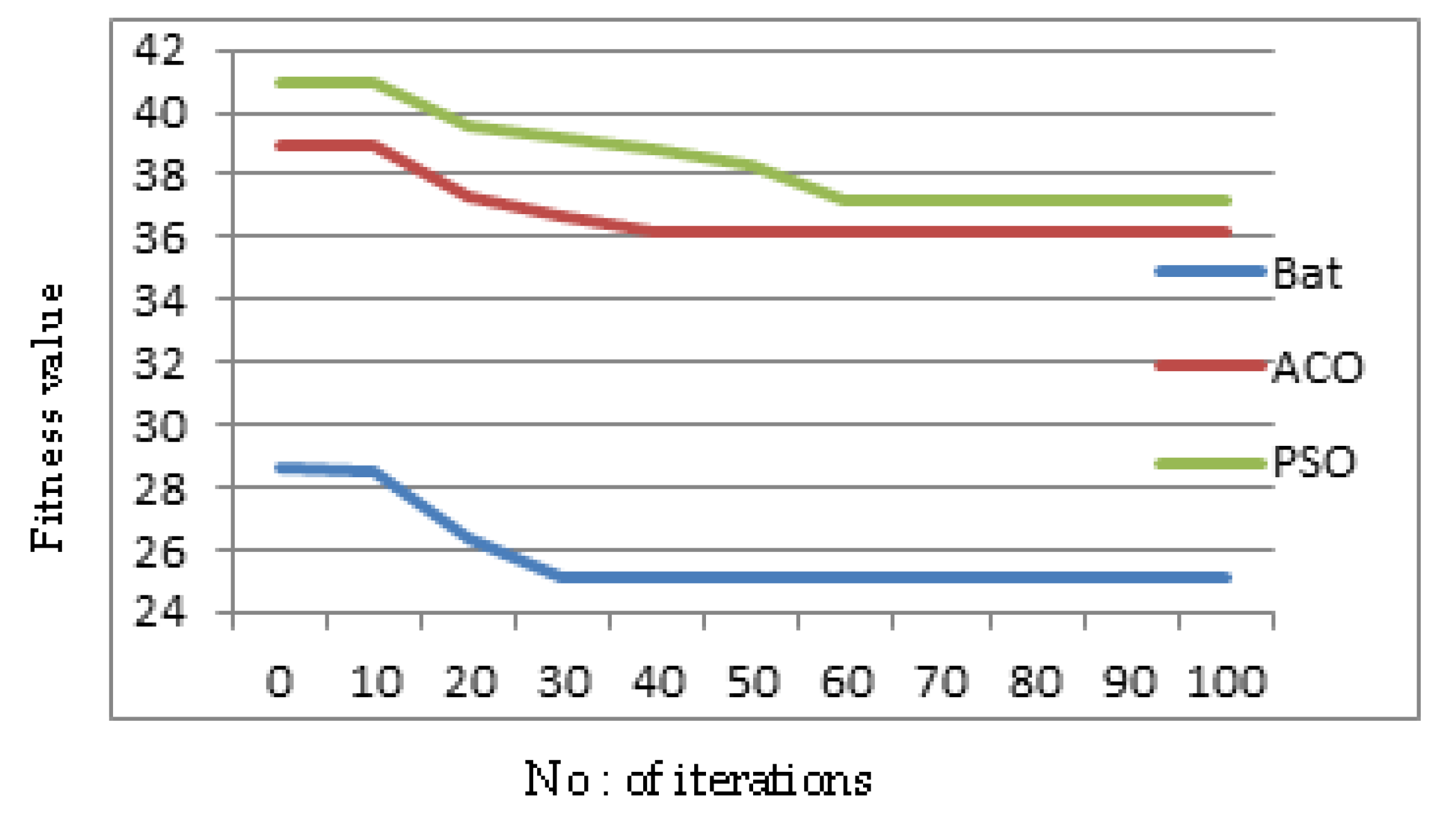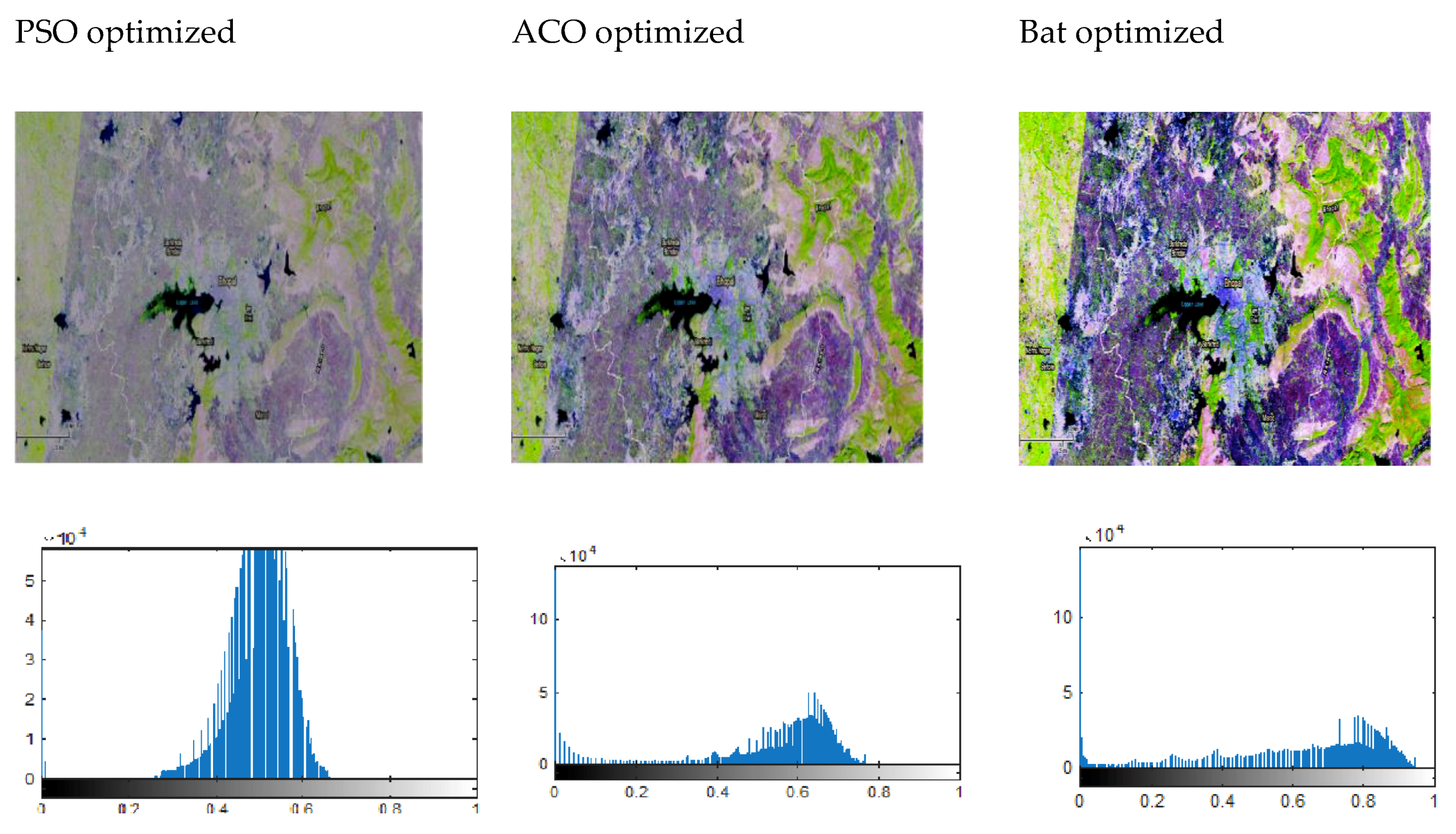Bat Algorithm Based Non-linear Contrast Stretching for Satellite Image Enhancement
Abstract
1. Introduction
2. Materials and Methods
2.1. Histogram Equalization
2.2. Contrast Stretching Transformation
2.3. BAT Optimized Contrast Stretching
- (i)
- Bats use the echos to measure the distance and can identify the difference between food and obstacles.
- (ii)
- Bats fly with a velocity vi at a position xi, having a frequency fmin and degree of loudness A0 to search the prey.
- (iii)
- The loudness of the bats vary by a great extend and changes from a large positive value A0 to a minimum value Amin.
- Initialize the n bat population randomly and it is considered that each bat represents a solution to the optimization problem. This algorithm is used to find the optimal values for a, b, c and k. The parameters of the bat algorithm are initialized. Let the bat population size n = 20, number of iterations = 100, pulse rate = 0.4, fmin = 0.1, fmax = 2, loudness = 0.5.
- Initialize the search space for the control parameters a = [0, 1.5], b = [0, 0.5], c = [0, 1] and k = [0.5, 1.5].
- Retain the current best value and find the new solutions by moving the bats around the search space. After each iteration, fitness value is computed and the new frequency, position and velocity are updated using Equations (12)–(14) as:where β is a random value in [0, 1], x* is the current best solution. Here the fitness value computed is the MSE. A local search to change the current best solution is performed using random walk and is given by Equation (15):where At is the average loudness of the bat and ε is a random value chosen from [−1,1]. The search path is modified in terms of the pulse rate r and loudness A which are also to be updated with the iteration using Equations (16) and (17):where α and γ are constants such that 0 < α < 1 and γ > 0. Figure 2 shows the bat optimization algorithm.
2.4. ACO Optimization
2.5. PSO Optimization
3. Results
4. Discussion
5. Conclusions
Author Contributions
Funding
Conflicts of Interest
References
- Kaplan, N.H. Remote sensing image enhancement using hazy image model. Optik 2018, 155, 139–148. [Google Scholar] [CrossRef]
- Wan, M.; Gu, G.; Qian, W.; Ren, K.; Chen, Q.; Maldague, X. Particle swarm optimization-based local entropy weighted histogram equalization for infrared image enhancement. Infrared Phys. Technol. 2018, 91, 164–181. [Google Scholar] [CrossRef]
- Rundo, L.; Tangherloni, A.; Nobile, M.S.; Militello, C.; Besozzi, D.; Mauri, G.; Cazzaniga, P. MedGA: A novel evolutionary method for image enhancement in medical imaging systems. Expert Syst. Appl. 2019, 119, 387–399. [Google Scholar] [CrossRef]
- Singh, M.; Verma, A.; Sharma, N. Bat optimization based neuron model of stochastic resonance for the enhancement of MR images. Biocybern. Biomed. Eng. 2017, 37, 124–134. [Google Scholar] [CrossRef]
- Tang, S.; Wu, B.; Zhu, Q. Combined adjustment of multi-resolution satellite imagery for improved geo-positioning accuracy. ISPRS J. Photogramm. Remote Sens. 2016, 114, 125–136. [Google Scholar] [CrossRef]
- Jadhav, B.D.; Patil, P.M. Satellite image resolution enhancement using Dyadic-integer coefficients based bi-orthogonal wavelet filters. Procedia Comput. Sci. 2015, 49, 17–23. [Google Scholar] [CrossRef]
- Shakeri, M.; Dezfoulian, M.H.; Khotanlou, H.; Barati, A.H.; Masoumi, Y. Image contrast enhancement using fuzzy clustering with adaptive cluster parameter and sub-histogram equalization. Digit. Signal Process. 2016, 1, 1–13. [Google Scholar] [CrossRef]
- Tian, Q.C.; Cohen, L.D. A variational-based fusion model for non-uniform illumination image enhancement via contrast optimization and color correction. Signal Process. 2018, 153, 210–220. [Google Scholar] [CrossRef]
- Chang, Y.C. A flexible contrast enhancement method with visual effects and brightness preservation: Histogram planting. Comput. Electr. Eng. 2018, 69, 796–807. [Google Scholar] [CrossRef]
- Singh, H.; Kumar, A.; Balyan, L.K.; Singh, G.K. A novel optimally weighted framework of piecewise gamma corrected fractional order masking for satellite image enhancement. Comput. Electr. Eng. 2017, 1–17. [Google Scholar] [CrossRef]
- Cao, G.; Huang, L.; Tian, H.; Huang, X.; Wang, Y.; Zhi, R. Contrast enhancement of brightness-distorted images by improved adaptive gamma correction. Comput. Electr. Eng. 2017, 66, 1–14. [Google Scholar] [CrossRef]
- Varghese, A.K.; Nisha, J.S. A Novel Approach for Image Enhancement Preserving Brightness Level using Adaptive Gamma Correction. Int. J. Eng. Res. 2015, 4, 842–847. [Google Scholar]
- Jiang, G.; Wong, C.Y.; Lin, S.C.F.; Rahman, M.A.; Ren, T.R.; Kwok, N.; Shi, H.; Yu, Y.H.; Wu, T. Image contrast enhancement with brightness preservation using an optimal gamma correction and weighted sum approach. J. Mod. Opt. 2015, 62, 536–547. [Google Scholar] [CrossRef]
- Suresh, S.; Lal, S. Modified differential evolution algorithm for contrast and brightness enhancement of satellite images. Appl. Soft Comput. J. 2017, 61, 622–641. [Google Scholar] [CrossRef]
- Bhandari, A.K.; Soni, V.; Kumar, A.; Singh, G.K. Artificial Bee Colony-based satellite image contrast and brightness enhancement technique using DWT-SVD. Int. J. Remote Sens. 2014, 35, 1601–1624. [Google Scholar] [CrossRef]
- Chen, J.; Yu, W.; Tian, J.; Chen, L.; Zhou, Z. Image contrast enhancement using an artificial bee colony algorithm. Swarm Evol. Comput. 2018, 38, 287–294. [Google Scholar] [CrossRef]
- Parihar, A.S.; Verma, O.P.; Yadav, D. Image Contrast Enhancement Using Differential Evolution. Lect. Notes Electr. Eng. 2018, 462, 517–526. [Google Scholar]
- Liu, J.; Zhou, C.; Chen, P.; Kang, C. An Efficient Contrast Enhancement Method for Remote Sensing Images. IEEE Geosci. Remote Sens. Lett. 2017, 14, 1715–1719. [Google Scholar] [CrossRef]
- Maurya, L.; Mahapatra, P.K.; Kumar, A. A social spider optimized image fusion approach for contrast enhancement and brightness preservation. Appl. Soft Comput. 2017, 52, 575–592. [Google Scholar] [CrossRef]
- Santhi, K.; Wahida Banu, R.S.D. Adaptive contrast enhancement using modified histogram equalization. Optik 2015, 126, 1809–1814. [Google Scholar] [CrossRef]
- Panigrahi, B.K.; Suganthan, P.N.; Das, S.; Satapathy, S.C. Differential Evolution for Optimizing the Hybrid Filter Combination in Image Edge Enhancement. In Swarm, Evolutionary, and Memetic Computing Second; Springer: Berlin, Germany, 2011; pp. 1–352. ISBN 9783642272417. [Google Scholar]
- Tuba, M.; Jordanski, M.; Arsic, A. Improved weighted thresholded histogram equalization algorithm for digital image contrast enhancement using the bat algorithm. In Bio-Inspired Computation and Applications in Image Processing; Academic Press: Amsterdam, The Netherlands, 2016; ISBN 9780128045367. [Google Scholar]
- Oonsrikaw, Y.; Thammano, A. Modified ant colony optimization algorithm for multiple-vehicle traveling salesman problems. Int. J. Netw. Distrib. Comput. 2018, 7, 29–36. [Google Scholar] [CrossRef]
- Mary, G.G.; Rani, M.M.S. Application of ant colony optimization for enhancement of visual cryptography images. In Nature Inspired Optimization Techniques for Image Processing Applications; Springer: Berlin, Germany, 2019; pp. 147–163. [Google Scholar]
- Bhandari, A.K.; Kumar, D.; Kumar, A.; Singh, G.K. Optimal sub-band adaptive thresholding based edge preserved satellite image denoising using adaptive differential evolution algorithm. Neurocomputing 2016, 174, 698–721. [Google Scholar] [CrossRef]
- Singh, H.; Kumar, A.; Balyan, L.K.; Singh, G.K. Swarm intelligence optimized piecewise gamma corrected histogram equalization for dark image enhancement. Comput. Electr. Eng. 2017, 70, 1–14. [Google Scholar] [CrossRef]






| Algorithms | Parameters | Values |
|---|---|---|
| PSO | Swarm size | 200 |
| Number of iterations | 100 | |
| Cognitive and social acceleration Constant (c1, c2) | 2.2 | |
| Inertia weight (w) | 0.9 | |
| ACO | Initial pheromone | 0.5 |
| Evaporation rate | 0.1 | |
| Population size | 200 | |
| Number of iterations | 100 | |
| Bat optimization | Bat population size | 20 |
| Number of iterations | 100 | |
| Pulse rate | 0.4 | |
| fmin | 0.1 | |
| fmax | 2 | |
| Loudness | 0.5 |
| Technique | PSNR (dB) | MSE | AMBE | Entropy | CPU Time (sec) | |
|---|---|---|---|---|---|---|
| Bat algorithm optimized contrast stretching | Sample 1 | 46.4995 | 25.1662 | 9.8124 | 6.1722 | 216.1233 |
| Sample 2 | 45.3112 | 26.7190 | 12.7835 | 6.0912 | 222.3012 | |
| Sample 3 | 43.1225 | 28.4633 | 12.9034 | 5.8924 | 224.0944 | |
| ACO optimized contrast stretching | Sample 1 | 36.9019 | 34.2113 | 11.1093 | 5.5105 | 362.0443 |
| Sample 2 | 38.1122 | 32.9013 | 14.9012 | 5.3922 | 356.6544 | |
| Sample 3 | 36.7883 | 33.8136 | 13.9983 | 5.3422 | 359.1456 | |
| PSO optimized contrast stretching | Sample 1 | 34.0084 | 37.1105 | 16.9012 | 5.2101 | 421.3429 |
| Sample 2 | 35.6488 | 37.0144 | 18.9481 | 5.1044 | 435.0934 | |
| Sample 3 | 33.1209 | 39.2041 | 19.2018 | 5.0023 | 430.0122 |
© 2020 by the authors. Licensee MDPI, Basel, Switzerland. This article is an open access article distributed under the terms and conditions of the Creative Commons Attribution (CC BY) license (http://creativecommons.org/licenses/by/4.0/).
Share and Cite
Asokan, A.; Popescu, D.E.; Anitha, J.; Hemanth, D.J. Bat Algorithm Based Non-linear Contrast Stretching for Satellite Image Enhancement. Geosciences 2020, 10, 78. https://doi.org/10.3390/geosciences10020078
Asokan A, Popescu DE, Anitha J, Hemanth DJ. Bat Algorithm Based Non-linear Contrast Stretching for Satellite Image Enhancement. Geosciences. 2020; 10(2):78. https://doi.org/10.3390/geosciences10020078
Chicago/Turabian StyleAsokan, Anju, Daniela E. Popescu, J. Anitha, and D. Jude Hemanth. 2020. "Bat Algorithm Based Non-linear Contrast Stretching for Satellite Image Enhancement" Geosciences 10, no. 2: 78. https://doi.org/10.3390/geosciences10020078
APA StyleAsokan, A., Popescu, D. E., Anitha, J., & Hemanth, D. J. (2020). Bat Algorithm Based Non-linear Contrast Stretching for Satellite Image Enhancement. Geosciences, 10(2), 78. https://doi.org/10.3390/geosciences10020078






